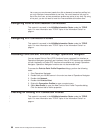v IP_DROP_MEMBERSHIP: Leaves the multicast group specified.
v IP_MULTICAST_IF: Sets the interface over which outgoing multicast datagrams
should be sent.
v IP_MULTICAST_TTL: Sets the time to live (TTL) in the IP header for outgoing
multicast datagrams.
v IP_MULTICAST_LOOP: Specifies whether or not a copy of an outgoing multicast
datagram should be delivered to the sending host as long as it is a member of
the multicast group.
For additional information about sockets, including sample programs, see the
Sockets Programming
, SC41-5422-03 book. The
System API Reference
,
SC41-5801-03 documents the sockets API.
Multicast Restrictions
Multicast does not map well to all types of physical lines. For this reason, it is not
supported on all lines. For example, a switched network such as X.25 does not lend
itself to multicast applications because no mechanism exists for transmitting a
single packet to all systems in the network that have joined a group. IP multicast is
supported on broadcast capable networks and on SLIP/PPP interfaces, but it is not
supported on multi-access nonbroadcast networks. IP multicast is also not currently
supported on Frame Relay, FDDI/SDDI, or ATM networks. To determine whether an
interface supports multicast, enter option 14 on the Work with TCP/IP Interface
Status display. If the interface supports multicast, there will be at least one Host
Group entry for the All Hosts group 224.0.0.1. Otherwise, the interface does not
support multicast.
The 2626 token-ring input-output processor (IOP) requires manual configuration to
receive multicast datagrams. In particular, you must specify the token-ring address,
C00000040000, on the functional address parameter for the token-ring line
description. To add this address to a line description that is named TRNLINE, use
the following command:
CHGLINTRN LIND(TRNLINE) FCNADR(C00000040000)
The 2617 Ethernet IOP also requires manual configuration in order to receive
multicast datagrams. The Ethernet group addresses to be received need to be
specified on the group address parameter (GRPADR) for the Ethernet line
description. A 4-byte IP multicast address is mapped to a 6-byte Ethernet group
address by placing the low-order 23 bits of the IP multicast address into the
low-order 23 bits of the Ethernet group address 01005E000000. For example, to
receive multicast datagrams with a destination address of 224.255.0.2, the
GRPADR parameter for the 2617 Ethernet line description must include
01005E7F0002.
92 OS/400 TCP/IP Configuration and Reference V4R4


















